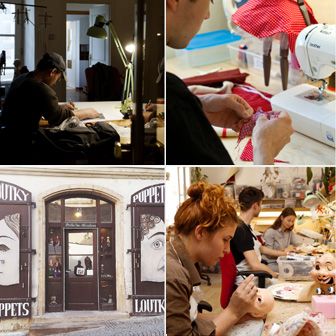Marionettes.cz
- Puppets
- Puppets for All
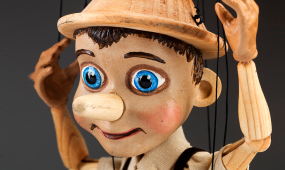 Are you looking for reasonably priced puppets that represent puppetry craft & tradition and we have them mostly in stock?
Are you looking for reasonably priced puppets that represent puppetry craft & tradition and we have them mostly in stock? - Art Puppets
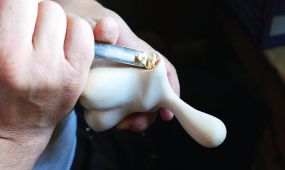 Art Marionettes are our best selection of puppets that are both unique and special in every possible way. Each creation is an original detailed piece of art. Art Marionettes will make a wonderful addition to your collection and they will bring joy and beauty into your home. Lifetime figurines that age like wine...For better clarity we've sorted them into a few categories bellow. So look at and enjoy :)
Katerina Novakova
Art Marionettes are our best selection of puppets that are both unique and special in every possible way. Each creation is an original detailed piece of art. Art Marionettes will make a wonderful addition to your collection and they will bring joy and beauty into your home. Lifetime figurines that age like wine...For better clarity we've sorted them into a few categories bellow. So look at and enjoy :)
Katerina Novakova - Performance Puppets
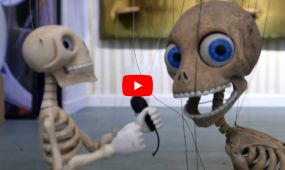 They are fully functional professionally articulated and balanced puppets. You'll meet them on the street, at a party, or in a video somewhere on social media. You can choose from our existing range, or you can come up with your own idea and we will make a professional puppet for you.
They are fully functional professionally articulated and balanced puppets. You'll meet them on the street, at a party, or in a video somewhere on social media. You can choose from our existing range, or you can come up with your own idea and we will make a professional puppet for you. - Custom
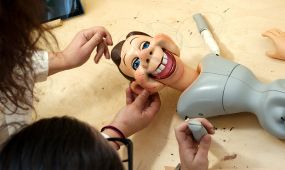 We are mastering the technique of hand carving and the modern technique of 3D printing. We use top-quality materials and techniques. We are able to communicate with you on a daily basis during the project to find the best possible way how to make your ideas come true.
We are mastering the technique of hand carving and the modern technique of 3D printing. We use top-quality materials and techniques. We are able to communicate with you on a daily basis during the project to find the best possible way how to make your ideas come true.
- Publications

- Puppets for All
- DIY & Parts
- Do it yourself - KITs
 Make your own marionettes. You're skilled to and we know it! Assemble a puppet from a pre-prepared set. Parts for making puppets. Made in Czech Republic. Safe materials. Wooden toys. Quality Czech product.
Make your own marionettes. You're skilled to and we know it! Assemble a puppet from a pre-prepared set. Parts for making puppets. Made in Czech Republic. Safe materials. Wooden toys. Quality Czech product. - Material for puppet construction
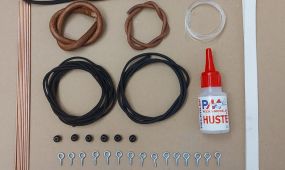 Nabízíme vám materiál a doplňky na stavbu marionet.
Nabízíme vám materiál a doplňky na stavbu marionet. - Marionette Stands
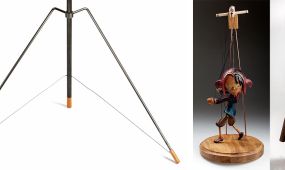 Would you like your marionette to be displayed on a nice stand? We have a couple of them to choose from. Have a look!Would you like your marionette to be displayed on a nice stand? We have a couple of them to choose from. Have a look!
Would you like your marionette to be displayed on a nice stand? We have a couple of them to choose from. Have a look!Would you like your marionette to be displayed on a nice stand? We have a couple of them to choose from. Have a look! - Control devices for marionettes
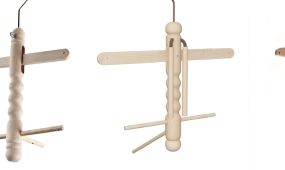
- Marionette bodies, heads, shoes
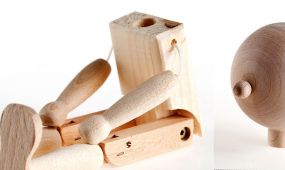 Marionette parts - bodies, heads, shoes
Marionette parts - bodies, heads, shoes
- Do it yourself - KITs
- Puppets for 3D printing
- Complete puppets for 3D printing
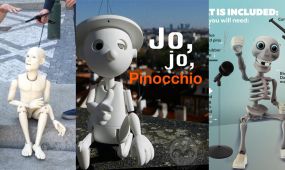 Here we have our database of animal puppets ready to print on 3D printers. We can also customize the files to your needs. The license for each file allows you to print up to 5 pieces.
Please note that the price of your order includes only the electronic 3D model file (*.stl). The printing of your puppet is up to you :)
Enjoy!
Here we have our database of animal puppets ready to print on 3D printers. We can also customize the files to your needs. The license for each file allows you to print up to 5 pieces.
Please note that the price of your order includes only the electronic 3D model file (*.stl). The printing of your puppet is up to you :)
Enjoy! - Bodies for 3D printing
 In this category, you can find many 3D models for printing. Please note your the price of your order includes an electronic file with a 3D model (*.stl) only. The printing of your marionette is down to you :)Enjoy!
In this category, you can find many 3D models for printing. Please note your the price of your order includes an electronic file with a 3D model (*.stl) only. The printing of your marionette is down to you :)Enjoy! - Heads for 3D printing
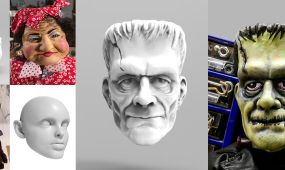 Here we have our database of marionette heads ready for printing at 3D printers. We can also customise the files to suit your needs. Please note your the price of your order includes an electronic file with 3D model (*.stl) only. The printing of your marionette is down to you :)Enjoy!
Here we have our database of marionette heads ready for printing at 3D printers. We can also customise the files to suit your needs. Please note your the price of your order includes an electronic file with 3D model (*.stl) only. The printing of your marionette is down to you :)Enjoy! - Shoes for 3D printing
 Choose the 3D model for printing shoes that you need for your marionette. Converse, varnish or basketball? You will also find a range of hats here.
Choose the 3D model for printing shoes that you need for your marionette. Converse, varnish or basketball? You will also find a range of hats here.
- Hands for 3D printing
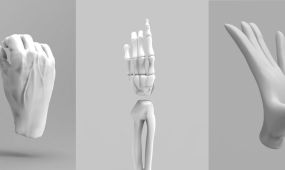 Here we have our database of marionette hands ready for printing at 3D printers. We can also customise the files to suit your needs. Please note your the price of your order includes an electronic file with 3D model (*.stl) only. The printing of your marionette is down to you :)Enjoy!
Here we have our database of marionette hands ready for printing at 3D printers. We can also customise the files to suit your needs. Please note your the price of your order includes an electronic file with 3D model (*.stl) only. The printing of your marionette is down to you :)Enjoy! - Controllers and Eye mechanics
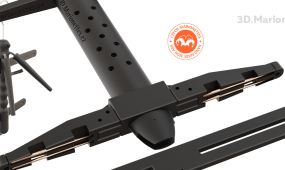 Here we have our database of files with 3D models of eye mechanisms or controllers in 3D ready for printing at 3D printers. We can also customise the files to your needs. Please note your the price of your order includes an electronic file with 3D model (*.stl) only. The printing of your marionette is down to you :)Enjoy!
Here we have our database of files with 3D models of eye mechanisms or controllers in 3D ready for printing at 3D printers. We can also customise the files to your needs. Please note your the price of your order includes an electronic file with 3D model (*.stl) only. The printing of your marionette is down to you :)Enjoy! - Props for 3D printing
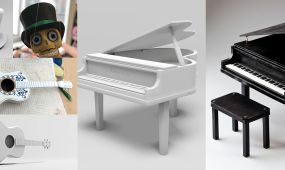 In this category you will find a number of different props in 3D models. Now you can print props of guitar, piano, and other musical instruments on a 3D printer.
In this category you will find a number of different props in 3D models. Now you can print props of guitar, piano, and other musical instruments on a 3D printer. - Services (3D printing, 3D modeling)
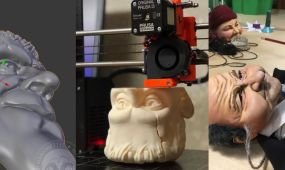 Order a 3D print or let us make the whole marionette
Order a 3D print or let us make the whole marionette - Filaments - printing strings
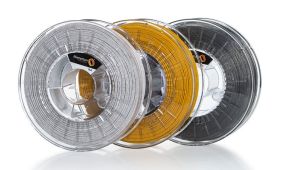 Filaments for 3D printers
Just as an inkjet printer needs a cartridge to print, 3D printers need printing filaments, also known as filaments. These most often differ in the material they are made of. Read on to find out what 3D filaments exist and how to choose between them.
Types of filaments
3D filaments are made from many materials, each with different properties that directly affect what the filament is suitable for. Let's take a look together at the most common types of filament.
PLA filament
PLA filament is made up of polylactic acid and is a popular choice for both beginner and advanced 3D printers. It is an eco-friendly and safe 3D filament used to make medical implants or consumer products such as food packaging or disposable tableware. It can be purchased in both glow-in-the-dark and traditional versions.
PETG filament
PETG filament is a modified and improved variation of PET filament. Due to its flexibility and impact resistance, it is used to produce protective phone covers or mechanical parts. Most PETG filaments are also safe for contact with food
Filaments for 3D printers
Just as an inkjet printer needs a cartridge to print, 3D printers need printing filaments, also known as filaments. These most often differ in the material they are made of. Read on to find out what 3D filaments exist and how to choose between them.
Types of filaments
3D filaments are made from many materials, each with different properties that directly affect what the filament is suitable for. Let's take a look together at the most common types of filament.
PLA filament
PLA filament is made up of polylactic acid and is a popular choice for both beginner and advanced 3D printers. It is an eco-friendly and safe 3D filament used to make medical implants or consumer products such as food packaging or disposable tableware. It can be purchased in both glow-in-the-dark and traditional versions.
PETG filament
PETG filament is a modified and improved variation of PET filament. Due to its flexibility and impact resistance, it is used to produce protective phone covers or mechanical parts. Most PETG filaments are also safe for contact with food
- Complete puppets for 3D printing
- Antique
- Workshops
- Sale








